The track is one of the riders’ favourites. It is also famous for its section known as “the corkscrew”
Let’s start with some history. In the 50s, the Monterey peninsula in California was the stage of several motor competitions that took place on public roads. These races became so popular that it was necessary to move them to a permanent track. Laguna Seca was born, funded by local businesses and private investors. The track was set up on disused land that was used by the army to carry out manoeuvres and test artillery.
This picturesque track has welcomed a multitude of competitions since its inauguration, including the USRRC, Can-Am, Trans-Am, Formula 5000, IMSA GT, Champ Car, American Le Mans Series, Grand-Am, Mundial de Superbike, MotoGP, and the Rolex Monterey Motorsports Reunion to name but a few. It became part of the World Championship in 1988 after the necessary adaptations were carried out to bring it up to modern standards. To increase safety, the straight that came off turn 2 was replaced with a slower section. This now makes up turns 3, 4, and 5, as well as extending the run-off areas and gravel traps.


Laguna Seca stopped hosting the World Championship from 1994 until 2005, the height of the MotoGP era. During this break, the last stretch of the track was changed, slowing down the entrance to turn 10 and creating a longer straight leading up to turn 11. These modifications meant that the length of each lap increased to the current 3610 meters. This track hosted the Grand Prix until 2013, its last year in the World Championship.
The track is one of the riders’ favourites. It is also famous for its section known as “the corkscrew”: a 130-metre downward slope to turn 9 with a 33-meter gradient change (equivalent to a ten-storey building). The first left bend starts at a 12% incline, which increases to 18% on the next right bend. The technical complexity of this section makes it a very exciting part where spectators can’t take their eyes off the road and anything could happen. Overtaking in this section is very difficult, and only two riders have managed to do it, one of those being none other than Marc Márquez in 2013.


The Repsol Honda Team has been enviably successful on the track.
- Six Victories: Nicky Hayden got his first victory on this track in 2005 and repeated this success in 2006. Dani Pedrosa obtained another victory in 2009, and his teammate Casey Stoner managed to reach the top of the podium in both 2011 and 2012. Marc has only ridden here once, but achieved an incredible victory that we remember as one of his biggest milestones.
- Nine Podiums In addition to the victories we have mentioned, our very own Samurai Dani Pedrosa got three further podiums for the team in 2006, 2011, and 2012.
- One Pole Position This unique milestone was achieved by World Champion Nicky Hayden in 2005 with his first victory.
- Five fastest laps: Pedrosa accumulated three fastest laps at Laguna Seca in 2006, 2009, and 2012. Casey got one in 2011, and Marc, of course, in 2013.
- As well as his 2013 victory, Marc Márquez set the record for being the first rookie to win on the track, and became theyoungest rider to win two consecutive GPs.
Laguna Seca stopped hosting the GP, leaving fans of the sport with great memories. The incredible track is not the only one to leave the World Championship behind. If you’d like to put your memory to the test, try it out with these famous oldies that staged some of the greatest GP races [1] [2] in their time.


 Join Us
Join Us  Join Us
Join Us 